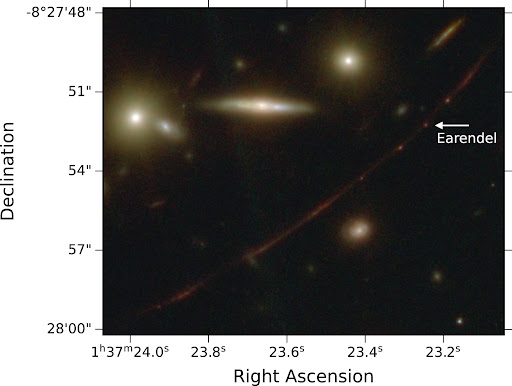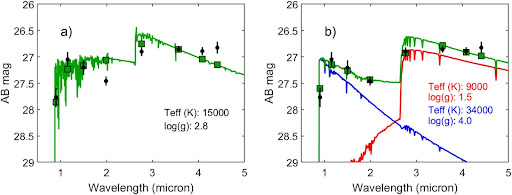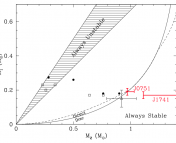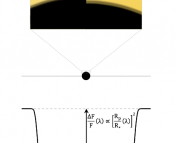Title: JWST Imaging of Earendel, the Extremely Magnified Star at Redshift z = 6.2
Authors: B. Welch, D. Coe, E. Zackrisson, et al.
First Author’s Institution: The Johns Hopkins University
Status: Published in The Astrophysical Journal [open access]
by Riley Owens

This guest post was written by Riley Owens, a postbaccalaureate researcher between groups at the American University of Sharjah and the University of Cincinnati. His research interests are broad, but focus upon the impact of massive stars throughout time. In his free time, he enjoys playing with his dog and long phone calls with friends.
Introduction
Galaxy clusters serve as powerful gravitational lenses that magnify the distant universe and enable the detection of small structures in galaxies. In some instances, these clusters can amplify the light from individual stars by thousands of times, so that they are visible even against their host galaxies. Initially observed as transients in Hubble Space Telescope (HST) images at redshifts around 1 to 1.5, lensed stars have been detected at much greater distances, including the current record holder from today’s paper at redshift 6.2.
Today’s paper presents new JWST imaging of the lensed star Earendel (named for the Old English word meaning ‘morning star’, and also inspired by J. R. R. Tolkien’s fictional character Eärendil), situated within the Sunrise Arc, a strongly gravitationally lensed galaxy.
Observations
Astronomers first identified Earendel with HST imaging taken as part of a galaxy cluster survey and a follow-up program (see this Astrobite). New imaging with JWST’s NIRCam (Figure 1) followed soon after as part of the telescope’s first year of observations. These images cover infrared wavelengths, but because of the galaxy’s large redshift, they correspond to ultraviolet and optical wavelengths when the galaxy originally emitted them.
In addition to the JWST imaging, today’s paper also includes infrared HST images taken across multiple years. This long delay is helpful because it can identify changes in the star’s brightness over time.

How big and bright is Earendel?
In a cosmological sense, even the biggest, hottest stars are very small and faint, so how magnified must Earendel be if we can see it when it lies >26 billion light years away (the approximate proper distance at z = 6.2)? To determine this, the authors used five lens models created from the discovery HST imaging. These model the distribution of mass in the cluster, most of which is in dark matter halos surrounding the composite galaxies. Accurately modeling the mass distribution can reproduce how the cluster distorts light from the background galaxy, including how much the lensing magnifies different images of the galaxy. After applying the lens models to the sharper JWST data, the authors find best-fit magnifications of Earendel of ~ 6,000 – 35,000x, and a lower limit of 4,000x ! This is an improvement compared to the HST-estimated magnifications of ~ 1,000 – 40,000x. The lensing magnification effect also causes a direct zoom-in, meaning that objects of larger magnification correspond to physically smaller ones. So, based on the magnification, the authors placed upper bounds on Earendel’s physical radius of ≲ 1,000 – 4,000 astronomical units (AU). Before, HST could only constrain its upper radius to ≲ 18,000 – 74,000 AU. For comparison, the smallest estimates of the size of the Öpik-Oort cloud surrounding our solar system are ~ 2,000 AU. This is the primary point of evidence suggesting that Earendel must be an extremely compact, small object. Without the assistance of gravitational lensing, it would be impossible to make such a remarkable observation of a minute object at an enormous distance.
Is Earendel just one star?
Initial spectral energy distribution (SED) fits were unable to simultaneously reproduce two features in the JWST photometry of Earendel: a strong Balmer break and a steep ultraviolet slope (a quantifier of the gradient in the ultraviolet continuum from the plotted spectrum) (Figure 2). The former is indicative of cooler stars, and the latter of hotter stars.
The authors suggest that if Earendel were a binary or multi-star system, this may explain the apparent discrepancy if there are stars of significantly different temperatures. They were able to produce a better SED fit with two stars of much different temperatures (Figure 2), but the limited available photometry and additional free parameters introduced from a multi-star fit means the properties of either hypothetical star are not well constrained.
Alternatively, the difficult-to-fit photometry could be connected to contamination from strong emission lines in the filters. These could be products of winds or H II regions surrounding Earendel. And some methods to measure the photometry favor shallower ultraviolet slopes that could be consistent with a single cool star.

Does Earendel twinkle?
With multi-epoch HST imaging, the authors explored if Earendel’s brightness noticeably varies. This could be caused either by intrinsic changes in the composite star/s, or the effect of microlensing. As the name suggests, microlensing typically refers to gravitational lensing caused by objects much less massive than galaxy clusters or galaxies. Here, it refers to short-term variations in the magnification of an object due to its relative motion in the source plane or slight changes in the arrangement of mass in the cluster. Because Earendel is an extremely compact object, its magnification will be sensitive to these small changes.
The imaging used to monitor variability is composed of 4 visits over the course of 2 years. The authors did not find unambiguous evidence of variability of Earendel’s brightness, which did not change by more than a factor of ~ 1.4 in the observations, consistent with their previous predictions that microlensing should not change the magnification by more than a factor of ~ 2. However, the apparent non-variation could be consistent with a multi-star system, since each star will have a slightly different position / motion in the source galaxy, and thus a different magnification. The separate variations in the individual magnifications due to microlensing could suppress changes in the overall magnification. If the variation were due to intrinsic changes in the star’s brightness, it could hint toward the identity of Earendel; perhaps a luminous blue variable star, for example.
Future
Additional NIRCam imaging and NIRSpec spectroscopy were executed after the publication of today’s paper. They will allow the authors to further constrain the SED fits with additional data points, estimate photometric contamination from emission lines, and better determine the stellar properties of the star/s of Earendel.
Astrobite edited by: Ali Crisp
Featured image credit: NASA, ESA, CSA, Dan Coe, Brian Welch, and Zoltan Levay




